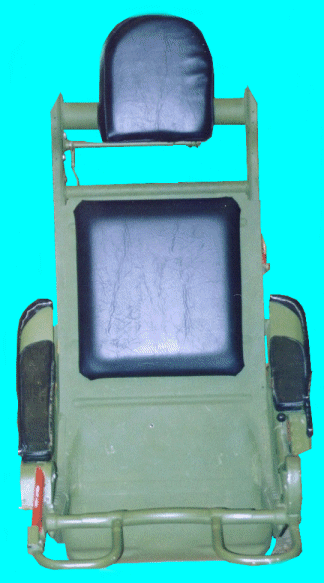 This seat is an example of a 1st Generation ejection seat. This seat used a gun catapult system and used manual lap belts, and manually operated seat pack parachutes.
This seat is an example of a 1st Generation ejection seat. This seat used a gun catapult system and used manual lap belts, and manually operated seat pack parachutes.
This seat was the first US-production ejection seat used. It bears more than a slight resemblance to the Heinkel 162 seat that was captured in the late part of World War II and brought back to the United States for development. The headrest and backpad shapes are nearly identical although the armrests and foot rests are clearly different. The firing mechanism used a two stage system where one lever is raised to arm the seat and the second raised to fire it.
The seat features an adjustable headrest and an inertia reel system that used a set of shoulder belts running up over the bar under the headrest. The reel itself can be seen at the base of the rear of the seat. The arm rests were designed to provide support for the upper body as early research indicated that this could lower the force transmitted to the spine significantly. This feature was used in most USAAF/USAF seats for years to come.
Seat separation was completely manual with the aircrew ejecting, then undoing the lap belt (which released the ends of the shoulder belts as well). Then the aircrew would push away from the seat and pull his rip-cord to deploy his parachute.
| Right side view |
| Left side view |
| Rear view |
| Bottom view |
This ejection seat was on display at theSAFE Association History of Escape Systems and the Evolution of Manikins Display during the SAFE Association 40th annual Symposium, October 2002
| The Ejection Site Home | |
|---|---|
| Send email to Kevin |